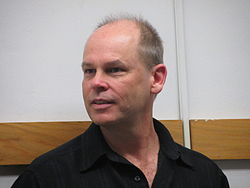Erik Ian Asphaug

Erik Ian Asphaug (born October 19, 1961 in Oslo, Norway) is a Norwegian American planetary science professor in the School of Earth and Space Exploration at University of Arizona. Asphaug received his bachelor's degree in mathematics and English from Rice University and his PhD in planetary science from the University of Arizona.
Until 2012, Asphaug served as a professor at the University of California at Santa Cruz.
The 1998 recipient of the Harold C. Urey Prize from the American Astronomical Society,[1] Asphaug is at the forefront of scientists studying the "rubble pile" composition of most asteroids and the implications of such composition on efforts to divert asteroids from striking the Earth. Asphaug has also worked with Urey Prize winner Robin M. Canup to develop new theories on how the Moon was formed. Recently he has studied the genesis of diverse small planets and asteroids in the aftermath of collisions between similar-sized planetoids during the middle to late stages of terrestrial planet formation.
Asphaug was involved in NASA's Galileo and LCROSS missions.[2][3] He is currently a principal advocate of a mission strategy to obtain a medical-like scan of the detailed interior structure of a Jupiter-family comet, which would reveal its origin, evolution and structure using techniques of 3D radar imaging and tomography.
Asteroid 7939 Asphaug was named in his honor.
Asphaug is an Eagle Scout.
Publications
[edit]- Impact Origin of the Moon?. In: Annual Revue of Earth and Planetary Sciences. March 2014.
- When the Earth Had Two Moons: Cannibal Planets, Icy Giants, Dirty Comets, Dreadful Orbits, and the Origins of the Night Sky (2019)[4]
References
[edit]- ^ "Harold C. Urey Prize in Planetary Science". American Astronomical Society. Retrieved 16 August 2011.
- ^ Asphaug, Erik (September 16, 1997). "Large Impact Features on Europa: Results of the Galileo Nominal Mission" (PDF). Archived from the original (PDF) on October 8, 2018. Retrieved July 19, 2017.
- ^ "NASA - NASA Ames Spacecraft to Smash into a Pole of the moon in Search of Ice". www.nasa.gov. Retrieved 2017-07-19.
- ^ Brown, Mike (3 January 2010). "'When the Earth Had Two Moons' Review: A Smashing Solar System". Wall Street Journal. Retrieved 4 January 2020.
External links
[edit]- Asphaug's web page at UCSC
- Asphaug's web page at ASU Archived 2020-10-12 at the Wayback Machine
- Asphaug's cumulative bio-bibliography Archived 2017-01-29 at the Wayback Machine
- http://adsabs.harvard.edu
| International | |
|---|---|
| National | |
| Academics | |
| Other | |
Text is available under the CC BY-SA 4.0 license; additional terms may apply.
Images, videos and audio are available under their respective licenses.
